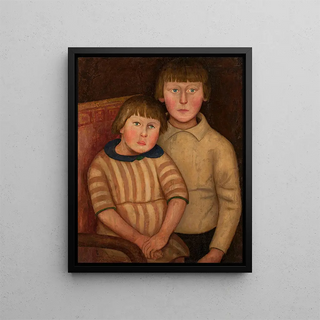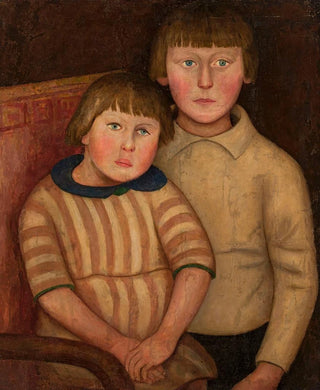Art print | Portrait of Two Children - Tadeusz Makowski


View from behind

Frame (optional)
The "Portrait of Two Children" by Tadeusz Makowski is a work that transcends the simple frame of a figurative representation. It invites the viewer to immerse themselves in a universe where childhood innocence blends with striking emotional depth. This painting, both tender and melancholic, captures the very essence of childhood through the expressive faces of the two children, whose gazes seem to carry a world of thoughts and dreams. Makowski, in his unique way of handling light and color, manages to create an atmosphere that resonates with each soul, making this piece a true timeless masterpiece.
Style and uniqueness of the work
Tadeusz Makowski's style is distinguished by its delicate and poetic approach. In "Portrait of Two Children," he uses a palette of soft colors, where pastel tones intertwine to bring the characters to life. The contours are softened, almost blurred, allowing for a sense of movement and gentleness. The children, dressed in traditional costumes, are depicted with particular attention to detail, each fold of fabric and every nuance of skin carefully crafted. This painting does not merely freeze a moment; it evokes a narrative, a silent story that encourages the viewer to imagine the lives of these children. The composition, balanced and harmonious, reinforces the idea of a deep connection between the two figures, highlighting the importance of family bonds and childhood.
The artist and his influence
Tadeusz Makowski, a Polish artist of the early 20th century, made his mark with a unique style that combined influences from naive art and post-impressionism. His artistic journey, although briefly interrupted by the tumult of history, left an indelible imprint on the art world. Makowski was particularly sensitive to themes of childhood and everyday life, which is evident in his works. His humanist approach and ability to capture the innocence and vulnerability of children allowed him to stand out among his contemporaries. Through "Portrait of Two Children," the artist offers us a glimpse of his

Matte finish

View from behind

Frame (optional)
The "Portrait of Two Children" by Tadeusz Makowski is a work that transcends the simple frame of a figurative representation. It invites the viewer to immerse themselves in a universe where childhood innocence blends with striking emotional depth. This painting, both tender and melancholic, captures the very essence of childhood through the expressive faces of the two children, whose gazes seem to carry a world of thoughts and dreams. Makowski, in his unique way of handling light and color, manages to create an atmosphere that resonates with each soul, making this piece a true timeless masterpiece.
Style and uniqueness of the work
Tadeusz Makowski's style is distinguished by its delicate and poetic approach. In "Portrait of Two Children," he uses a palette of soft colors, where pastel tones intertwine to bring the characters to life. The contours are softened, almost blurred, allowing for a sense of movement and gentleness. The children, dressed in traditional costumes, are depicted with particular attention to detail, each fold of fabric and every nuance of skin carefully crafted. This painting does not merely freeze a moment; it evokes a narrative, a silent story that encourages the viewer to imagine the lives of these children. The composition, balanced and harmonious, reinforces the idea of a deep connection between the two figures, highlighting the importance of family bonds and childhood.
The artist and his influence
Tadeusz Makowski, a Polish artist of the early 20th century, made his mark with a unique style that combined influences from naive art and post-impressionism. His artistic journey, although briefly interrupted by the tumult of history, left an indelible imprint on the art world. Makowski was particularly sensitive to themes of childhood and everyday life, which is evident in his works. His humanist approach and ability to capture the innocence and vulnerability of children allowed him to stand out among his contemporaries. Through "Portrait of Two Children," the artist offers us a glimpse of his






